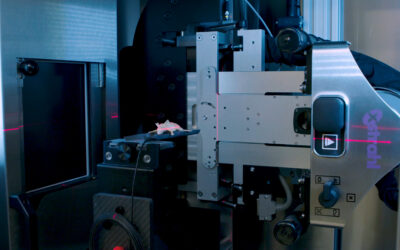For more than 10 years, the Small Animal Radiation Research Platform (SARRP) has supported countless investigators in complex radiation research initiatives, transforming the way research is conducted by enabling highly conformal radiation to be delivered to preclinical models.
What makes SARRP unique is that its design matches current clinical radiation therapy protocols, including support for immunotherapy and proton beam research as well. SARRP is used by academic research institutions, private contract research organizations, and pharmaceutical and biotech companies worldwide, showing a wide range of research interests.
The Radiation Research Community
Installed in nearly 100 facilities worldwide, SARRP has been cited as the primary research system employed in hundreds of peer-reviewed research publications, demonstrating the high quality of radiation research that can be performed using SARRP. As co-inventor Dr. John Wong explained, “SARRP is actually a catalyst now for so many multi-tiered applications and collaborations.” Truly, a community has developed around the technology – connecting scientists, inspiring new studies, and advancing research around the world. The halo effect of bringing researchers together is an invaluable benefit of the SARRP system.
Understanding Radiation & Fine-tuning Its Delivery
Some of the earliest work using SARRP revolved around quality assurance – creating new quality assurance protocols and procedures for radiation therapy and as well as new equipment. Adjacent technologies have also been incorporated in SARRP studies to perform advanced ultrasound procedures on preclinical models to evaluate the vasculature before and after radiation therapy. Studies were also performed using SARRP to examine the impact of using different collimator sizes. One study evaluated whether you have to treat the entire tumor to have an abscopal effect on other sites of the disease far away from the primary tumor. SARRP has also been used in studies of targeted nano-particles combined with radiation for tumor vascular modulation. And more recently, investigators used SARRP to deliver radiation specifically to a primary tumor and then measured the circulating tumor cell clusters in vivo, to better understand which ones may be on their way to generating metastases.
Facilitating Collaboration & Advancing New Trials
One early SARRP research institute reports having received more than $17M in research grants, in part due to SARRP. At this organization, more than 45 individuals use SARRP across seven departments and four schools, resulting in research that has led to the development of five clinical trials (4 human, 1 canine). Another group described collaborating with its Urology department to look at radiation cystitis and some of the genetics behind sensitivity to radiation. SARRP became very important in this study because of its ability to deliver high doses of radiation in a very targeted way, avoiding all of the other abdominal organs, and just concentrating that dose on the bladder. SARRP offers translational ability because it can be used to test novel compounds in the preclinical model, where researchers can reproducibly deliver radiation to cause radiation cystitis.
Proton Beam Studies & FLASH Radiotherapy
Working together with Xstrahl in 2016, one large academic research institution installed SARRP in a vault without any shielding, creating one of the first situations with both the photon and proton SARRP. Xstrahl helped to customize the system so that it could be more mobile, enabling preclinical models to move in and out of the beam’s path for more detailed positioning and analysis. SARRP users are also collaborating to create a specialized SARRP for FLASH featuring high-current capacity, self-shielding, and the ability to rotate sources to facilitate FLASH research.
Alzheimer’s Disease
In another institution, researchers have pioneered use of low-dose radiation as a potential treatment for Alzheimer’s disease. The SARRP played a crucial role in these pre-clinical studies by facilitating a hemi-brain irradiation technique such that one half of the same brain acted as a control for the irradiated side. They have shown a significant reduction in both amyloid-beta plaques and tau protein in the irradiated brain that led to an improvement in cognition in the mouse models. This data led to a Phase I feasibility trial of low-dose whole-brain radiation for Alzheimer’s disease that is now being replicated at Virginia Commonwealth University, University of Geneva, and also in South Korea. SARRP helped to support this novel idea because it is able to do very distinct hemi-brain irradiations to see the effect directly.
Pulse Dose Treatment of Glioblastoma
Investigators have also studied pulse dose treatment of glioblastoma using SARRP. This is work that Brian Marples started many years ago with Mike Joiner when they identified low-dose hyper-radiosensitivity, a phenomenon that occurs with doses below 0.2 Gy—at these low doses, there are more cells killed per unit dose. After many years of research, and many iterations of how to actually exploit this phenomenon, they came up with the idea of pulsing the radiation dose which worked successfully in animal models of glioma and was recently translated into a clinical trial of primary glioma in patients. Most of these patients have a survival of approximately 14 months, which was increased to 21 months in trials, as well as improvement to neurocognition and some quality of life measures.
Focal Irradiation & Regenerative Medicine
SARRP provides the ability to deliver focal high dose irradiation to preclinical models and has enabled researchers to simplify this procedure tremendously to irradiate portions of the liver and other targeted areas throughout the body – from the brain to the rectum and the limbs’ extremities. These advancements have led contributors to advance the field of regenerative medicine, showing that parenchymal cells such as liver, stem cells or adult hepatocytes, as well as endothelial cells can engraft and repopulate in an irradiated organ.
Radiation Sequencing & Immunotherapy
Using SARRP models, investigators have been able to explore radiation sequencing and immunotherapy, as well as how to sequence or how to combine radiation with immunomodulatory chemotherapy. Researchers have used SARRP to develop a number of different drug radiotherapy combinations. One study simultaneously investigated tumor efficacy in a number of different tumor models and also to exploit the onboard imaging capacity of SARRP to look at tissue density changes. The study attracted national attention and progressed to clinical evaluation.
Future Opportunities & Advancements
In looking ahead at future opportunities for investigation, SARRP not only provides a robust testing platform for drug-radiotherapy combinations, it will enable researchers to explore novel radiobiological paradigms based on optimized dose delivery parameters. Investigators can continue to integrate SARRP with novel radiotherapy and imaging technologies and combine this with the molecular and functional imaging to optimize and target specific regions within tumors and normal tissues.
“We are proud that we have contributed to strengthening the field of radiation research with SARRP and facilitating collaboration across the radiation research community,” explained Adrian Treverton, CEO of Xstrahl. “Customers worldwide routinely comment about the outstanding quality of Xstrahl’s entire support team and it is this team that deserves credit for SARRP’s reputation of reliability and quality. We are very excited about all the ways SARRP can support even more diverse research interests for the next decade and beyond,” he added.
Throughout the 10 years of SARRP and going forward, Xstrahl has been continuously innovating. Not only is Xstrahl proactive in enhancing the SARRP technology as advancements are made, but its innovative thinking extends to making SARRP technology more accessible and easy to use. By making a lab’s workflow easier while simultaneously enabling more advanced studies, Xstrahl moves a step closer to the shared end goal: to help eradicate cancer.







